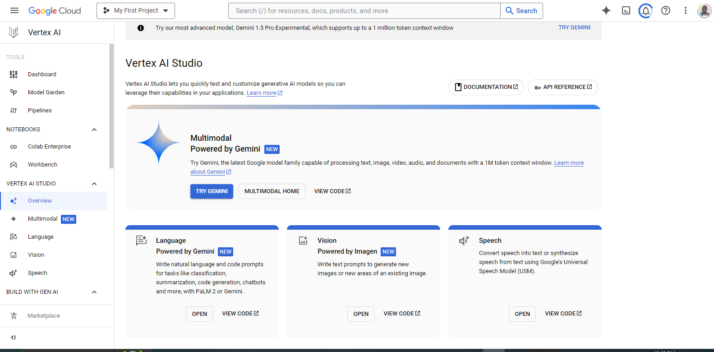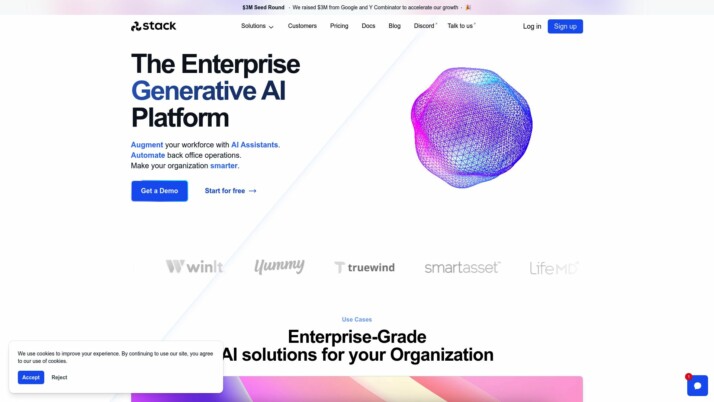Vertex AI vs. Stack AI: Comparing Advanced and Low-Code AI Development
AI development platforms have transformed the landscape of software engineering, empowering developers and businesses to harness cutting-edge machine learning capabilities. Vertex AI vs. Stack AI represent two distinct approaches to AI development, each offering unique strengths and trade-offs. This comparison delves into the features, use cases, and target audiences of these platforms, evaluating their ability to meet diverse AI development needs.
We’ll explore how Vertex AI’s comprehensive toolkit for advanced machine learning contrasts with Stack AI’s low-code approach, and introduce SmythOS as a powerful alternative that combines the strengths of both. By examining these platforms side-by-side, readers will gain valuable insights to inform their choice of AI development tools, understanding which solution best aligns with their technical expertise, project requirements, and business goals.
Vertex AI Overview
Vertex AI empowers developers to build, deploy, and scale machine learning models and AI applications. This comprehensive platform integrates various tools for data engineering, model training, and deployment, streamlining the entire machine learning lifecycle.


Screenshot from Vertex AI studio.
Vertex AI’s standout feature is its support for multimodal generative AI models, particularly the Gemini family. These models process text, images, audio, and video inputs, enabling diverse applications from chatbots to content generation. The platform’s Model Garden offers a curated collection of pre-trained models, including Google’s proprietary offerings and select open-source options, allowing users to quickly prototype and deploy AI solutions.
Vertex AI’s standout feature is its support for multimodal generative AI models, particularly the Gemini family. These models process text, images, audio, and video inputs…
The platform excels in model customization and management. Users can fine-tune models to specific use cases, improving performance and efficiency. Vertex AI’s MLOps tools facilitate model versioning, monitoring, and orchestration, ensuring smooth deployment and maintenance of AI systems at scale.
While Vertex AI provides powerful capabilities, it requires a degree of technical expertise to fully utilize. The platform lacks a true no-code editor, which may pose challenges for non-technical users. However, its integration with Google Cloud services and support for various APIs and data formats make it a versatile choice for organizations already invested in the Google ecosystem.
Vertex AI positions itself as a leader in enterprise AI development by offering advanced features like explainable AI, which provides insights into model decision-making processes. This transparency is crucial for industries where accountability is paramount. The platform’s robust security features, including data encryption and access controls, further solidify its appeal to businesses handling sensitive information.
Stack AI Overview
Stack AI empowers users to create and deploy AI-powered workflows and custom AI assistants without extensive coding expertise. The platform’s low-code approach democratizes access to advanced AI capabilities, making it accessible to a wide range of users from developers to business professionals.
Stack AI’s visual interface stands out as a key feature, allowing users to build complex AI models through intuitive drag-and-drop tools. This approach significantly reduces the barrier to entry for AI development, enabling rapid prototyping and deployment of AI solutions. The platform also offers pre-built templates for common use cases, further streamlining the development process for users with varying levels of technical expertise.


Screenshot of Stack AI Website
Stack AI’s visual interface stands out as a key feature, allowing users to build complex AI models through intuitive drag-and-drop tools.
Security and compliance form a cornerstone of Stack AI’s offering. The platform boasts enterprise-grade security measures, including SOC 2, HIPAA, and GDPR compliance. This robust security framework ensures that sensitive data remains protected throughout the AI development and deployment process, making Stack AI suitable for use in highly regulated industries.
Stack AI’s flexibility in deployment options sets it apart from competitors. Users can choose to deploy their AI applications with customizable user interfaces or as API endpoints, allowing for seamless integration with existing systems and workflows. This versatility enables organizations to tailor their AI solutions to specific business needs and technical environments.
The platform’s extensive integration capabilities further enhance its utility. Stack AI supports connections with a wide array of data sources and services, including popular tools like Google Drive, Salesforce, Airtable, and Slack. These integrations allow for smooth data flow and process automation across various business applications, maximizing the impact of AI solutions within an organization’s existing technology stack.
Feature Comparison
Vertex AI and Stack AI offer contrasting approaches to AI development and deployment. Vertex AI provides a comprehensive platform for advanced machine learning workflows, while Stack AI focuses on low-code AI application development.
Vertex AI excels in offering powerful tools for data scientists and ML engineers. It supports complex model training, deployment, and management across various AI tasks. The platform integrates seamlessly with Google Cloud services, enabling scalable AI solutions. However, Vertex AI lacks a true no-code editor, potentially limiting accessibility for non-technical users.
Stack AI prioritizes ease of use with its visual interface and low-code approach. This makes AI development more accessible to a broader audience, including business users without extensive coding skills. Stack AI offers pre-built templates and customizable deployments, streamlining the process of creating AI-powered workflows and assistants. While powerful for rapid prototyping and deployment, Stack AI may have limitations for highly specialized or complex AI tasks compared to Vertex AI’s more comprehensive toolkit.
In terms of security, both platforms offer robust measures. Vertex AI leverages Google’s enterprise-grade security infrastructure, while Stack AI emphasizes compliance with standards like SOC 2, HIPAA, and GDPR. This makes both suitable for organizations handling sensitive data, though Vertex AI may have an edge in large-scale enterprise deployments.
Feature Comparison Table
| Vertex AI | Stack AI | SmythOS | |
|---|---|---|---|
| CORE FEATURES | |||
| No-Code Options | ❌ | ✅ | ✅ |
| Audit Logs for Analytics | ❌ | ✅ | ✅ |
| SECURITY | |||
| Constrained Alignment | ✅ | ❌ | ✅ |
| IP Control | ✅ | ❌ | ✅ |
| COMPONENTS | |||
| Huggingface AIs | ❌ | ❌ | ✅ |
| Zapier APIs | ❌ | ✅ | ✅ |
| DEPLOYMENT OPTIONS (EMBODIMENTS) | |||
| Deploy as Scheduled Agent | ✅ | ❌ | ✅ |
| DATA LAKE SUPPORT | |||
| Sitemap Crawler | ❌ | ❌ | ✅ |
| YouTube Transcript Crawler | ❌ | ❌ | ✅ |
Best Alternative to Vertex AI and Stack AI
SmythOS stands out as the superior alternative to Vertex AI and Stack AI for agentic AI automation. Our platform combines power and accessibility, offering a comprehensive solution for businesses and developers seeking to harness AI’s potential.
Unlike Vertex AI’s complex toolset and Stack AI’s limited customization, SmythOS provides a user-friendly drag-and-drop interface that doesn’t sacrifice advanced capabilities. We empower users to create sophisticated AI agents without extensive coding knowledge, making AI development accessible to a broader audience.
SmythOS provides a user-friendly drag-and-drop interface that doesn’t sacrifice advanced capabilities. We empower users to create sophisticated AI agents without extensive coding knowledge…
SmythOS excels in its extensive integration ecosystem, supporting a wide array of APIs, AI models, and tools. This flexibility allows seamless incorporation into existing workflows and business processes, surpassing the integration capabilities of both Vertex AI and Stack AI. Our pre-built API integrations and templates significantly reduce setup time, enabling users to focus on innovation rather than implementation details.
We offer unparalleled versatility in deployment options. SmythOS-built agents can be deployed across various platforms, including as APIs, chatbots, scheduled tasks, and even as ChatGPT plugins. This adaptability ensures that our AI solutions can be integrated into diverse systems and applications, a feature not matched by either Vertex AI or Stack AI.
SmythOS sets itself apart with its robust security features and scalability. Our platform includes advanced data encryption, OAuth support, and IP control, addressing the security concerns that are critical for enterprise-level deployments. Additionally, SmythOS’s scalable architecture ensures that your AI solutions can grow alongside your business needs, providing a future-proof investment in AI technology.
Conclusion
Vertex AI and Stack AI offer powerful AI development platforms, each with unique strengths. Vertex AI excels in providing advanced machine learning tools and seamless integration with Google Cloud services, making it ideal for data scientists and ML engineers tackling complex AI projects. Stack AI, with its low-code approach and visual interface, democratizes AI development, enabling a wider range of users to create AI-powered workflows and assistants quickly.
However, SmythOS emerges as the superior choice, combining the best of both worlds. Our platform offers an intuitive drag-and-drop interface similar to Stack AI, making AI development accessible to non-technical users. At the same time, we provide the advanced capabilities and scalability that rival Vertex AI, supporting a vast array of AI models and integrations.
SmythOS stands out with its “Create Once, Deploy Anywhere” philosophy, allowing users to build AI agents that can be easily deployed across multiple platforms and services. This versatility, coupled with our extensive integration ecosystem of over 300,000 connections, empowers users to create sophisticated AI solutions that seamlessly fit into existing workflows.
For those ready to experience the future of AI development, we invite you to explore our diverse range of AI-powered agent templates and create a free SmythOS account. With our risk-free trial offering unlimited agents and a 30-day money-back guarantee, you can start building and deploying AI agents today, transforming your business processes and unlocking new levels of productivity and innovation.
Last updated:
Disclaimer: The information presented in this article is for general informational purposes only and is provided as is. While we strive to keep the content up-to-date and accurate, we make no representations or warranties of any kind, express or implied, about the completeness, accuracy, reliability, suitability, or availability of the information contained in this article.
Any reliance you place on such information is strictly at your own risk. We reserve the right to make additions, deletions, or modifications to the contents of this article at any time without prior notice.
In no event will we be liable for any loss or damage including without limitation, indirect or consequential loss or damage, or any loss or damage whatsoever arising from loss of data, profits, or any other loss not specified herein arising out of, or in connection with, the use of this article.
Despite our best efforts, this article may contain oversights, errors, or omissions. If you notice any inaccuracies or have concerns about the content, please report them through our content feedback form. Your input helps us maintain the quality and reliability of our information.
